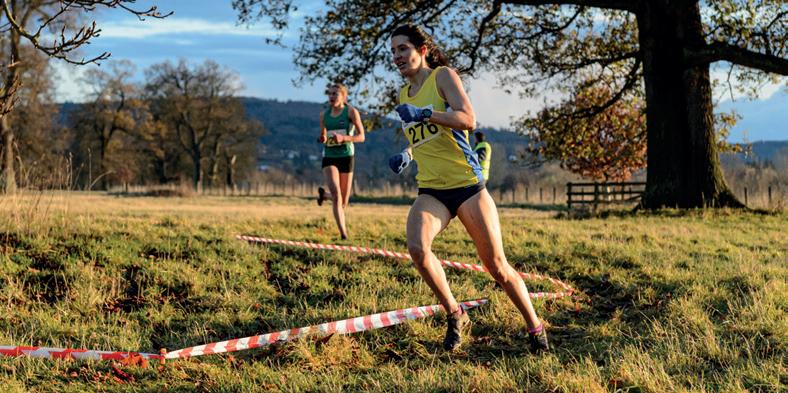
8 minute read
Exercise Addiction
When exercise becomes an addiction
Rest and recovery should be key aspects within training programmes for athletes and coaches
Advertisement

By Dr Rebecca Robinson & Dr Emily Todd
Training, resting, repeating, is a pattern that every runner from beginner to elite, junior to veteran, becomes accustomed to: but can spending more time doing the sport that you love be damaging? And can we do too much?
Dedication, discipline and commitment are aspirational traits in an athlete and we - as athletes, coaches, professionals within sport - may normalise these within the criteria for being a high level sportsperson or committed amateur.
Exercise addiction describes a compulsion to exercise and a dependence upon exercise that usually results in excessive amounts relative to a goal or to what is sustainable for health.
Regular athletic training and exercise addiction may often overlap and addiction can exist in otherwise healthy athletes, but its features can become problematic in a similar way to other addiction disorders when these have a negative impact on a balanced life, relationships and emotional wellbeing.
How is it possible to recognise exercise addiction?
Some signs to look out for can be the following: • Feelings of withdrawal when not exercising, or not able to exercise (which may include impact on mood, sleep, increased anxiety or irritability) • Spending a large or increasing amount of time doing exercise that might not be related to the time needed to attain a goal (or needing a higher amount to get the same level of satisfaction)
• Reduction in other activities or social life to accommodate training
• Continuing to exercise when this impinges on other aspects of health or interpersonal or work commitments
• Being unable to control exercise, which may include stopping when this is needed
As a healthy athlete or as a coach of athletes, it can be important to review motivation for training. This can help ensure time spent training is through meaningful exercise, or for the enjoyment of sport, with additional rehabilitation and add-ons (such as strength training) planned, but where there is clarity regarding time when training is completed, and adherence to rest when this is advised.
The ability to rest as part of a regular programme, or in management of illness, injury or other circumstances, is important refl ection of a healthy attitude to balance.
The following cases are examples of how exercise addiction might present:
Case 1: Training as a coping strategy
on furlough. He usually trained six days a week, running 1-2 times per day. As family were at home and their usual patterns was disrupted, with no demands from work, it seemed easy to go out for a little longer than planned. He felt he had additional time to complete strength work and fuel for his increased training. Over a period of two months, training volume slowly increased slowly at fi rst, but ultimately increased by 30%. Athlete A was tired and struggling to maintain mood and sleep which he attributed to balancing family care in the change of circumstances. When he developed a sore Achilles he continued to run, despite understanding the need for rest. Ultimately the injury stopped him from training, but he continued to cross train and sustained a groin injury. On accessing physiotherapy remotely, the physiotherapist enquired about his mood, assessing that he was very distressed at the inability to train, and it was recognised by the athlete that without training, his mood was very low.
In exercise addiction, behaviour is continued despite harmful consequences. It can become increasingly diffi cult not to surpass the intended amount of training.
An injury or illness can reveal an exercise addiction that has developed gradually, and this may present as an alteration in mood or loss of coping strategy that seems disproportionate to the loss of an exercise activity.
Within sport psychology, work with athletes can investigate motivation and can help the individual be aware of personal drivers for enjoyment and reward, so that they can attain a balance. This can help build recognition about when they might be asking too much of their physical activity or sport to meet multifactorial lifestyle needs.

Recognising this imbalance can be supported by health professionals, selfrecognition, work between an athlete and coach, and discussing issues with fellow athletes as well as family can widen a support network.


Case 2: Impact of over-training
Athlete B is a 22 year old talented athlete who went to university on a sport scholarship.
She usually trained four times a week as a middle distance runner and enjoyed playing hockey and also drama alongside her studies.
When she began university, she felt driven to prove that she was worthy of the scholarship and was determined to train harder and longer.
She added her own sessions to the university track schedule, so that she was training hard most days, and also joined new friends at university for easy paced runs.
After three months, her performance was dropping, with increased frequency of colds disrupting her training and she felt tired all of the time. She felt very frustrated that even despite her hard work she was not progressing.
Training can be driven forward by positive reinforcement of good results and achieving goals, but over-training causes performance to deteriorate because there is a limit to the body’s ability to adapt, at a musculoskeletal, central nervous system and psychological level.
This can present as the underperformance syndrome - where fatigue is a main presenting feature, but in which impact to the body’s energy systems (hormonal dysfunction), immune health and digestive health as well as mood and sleep can be affected.
Negative reinforcement then occurs because the athlete is not meeting the goals that they have set, despite training harder. This is often seen at a time of transition, such as from junior to senior level. energy defi ciency syndrome can occur and should not be missed in the athlete who is overtraining due to exercise addiction. Presentation in RED-S is often also with fatigue, typically cessation of menstrual cycles in the female athlete, and may present with a bone injury due to the combination of high training load but also reduced recovery and unmet nutrition needs, in the context of low hormone levels due to the body’s response in trying to save energy





Dr Emily Todd (on right)
How to recognise exercise addition and get help
This article outlines some of the key features of exercise addiction and it is hoped this might help athletes and their coaches to recognise when a love for sport becomes less healthy.
Asking some of the questions – to oneself and in a supportive training group can be helpful.
Sport and exercise and training for goals has very important positive physical, psychological and social impacts, and a lifelong enjoyment of sport can be transformative for many peoples’ lives. However, a recognition that sport should not be the ‘be all’ for an individual can help to nurture other aspects of their lives. This becomes important for wellbeing, but also crucial for times when exercise is not possible, safe or accessible.
If someone is struggling with exercise addiction, discussing with a coach is recommended.
For further individual support, seeking advice from their GP can be a gateway to help from a sports or clinical psychologist or sports medicine professional.
Treatment for exercise addiction is best managed by a mental health professional with expertise in sport, but can also be self-led.
Changing behaviour begins with recognition and a wish to change and there are some types of intervention that can help such as cognitive behavioural therapy.
Some outcomes of (CBT) can be learning how to become more fl exible with an exercise plan and develop new coping skills to manage distress rather than relying solely on exercise. Looking at whether the motivators for training are healthy or unhealthy is also important.
A healthy motivator may be pure enjoyment of the sport, a process-driven race goal or learning new skills.
Less healthy motivators might be a perception that the athlete needs to run fast to be happy, to attain praise or validate themselves, or a feeling that they ‘should’ train when they feel ill or tired or at the expense of other aspects of their balanced lives.
Other issues not to miss
It is possible to suffer from exercise addiction and meet energy needs adequately (primary exercise addiction), but the compulsive exercise is also seen in those with eating disorders (secondary exercise addiction). It is essential to identify athletes with eating disorders who do need specialist input because these have signifi cant health consequences.
Obsessional compulsive disorders might also present as compulsive over-exercising and specialist mental health support is important to help the individual return to healthy behaviours.
Although exercise can be very helpful for mental health, including for those with personal mental health disorders or stress in their past, some people can turn to exercise as their main way to deal with trauma or stress. Formal help to build a balanced coping strategy or to maintain self-esteem is important for longer term resilience.
Dr Rebecca Robinson
Consultant in Sport and Exercise Medicine Centre for Health and Human Performance and English Institute of Sport










